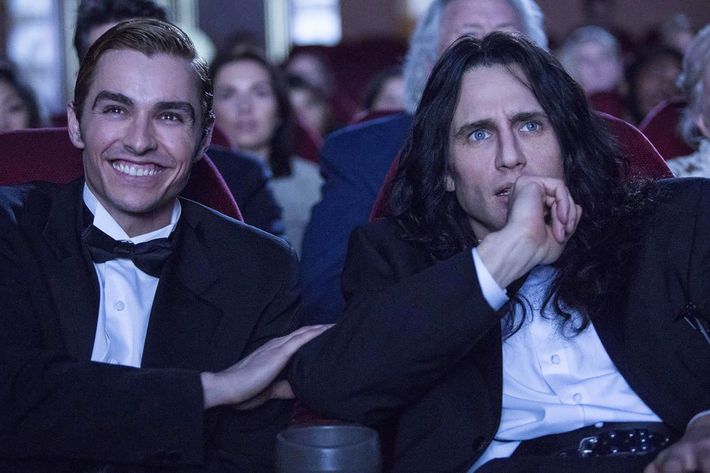How not to be a Disaster Artist
- Matt Dowse
- Dec 4, 2017
- 4 min read
An inquiry into my own directing style, using terrible movies as case studies.
This week I was lucky enough to receive a set of advanced preview tickets to the new James Franco film The Disaster Artist (2017) about two weeks before its’ general release in the UK. Directed, Produced by and starring Franco, the film chronicles the true story of filmmaker Tommy Wiseau, as he sets out to become a major Hollywood star and launch his career by making his own motion picture; The Room (2003). The Room was released in 2003 for a budget of $6,000,000 and initially made less than $2000 at the box office. It has a reputation for being the worst film ever made, often called the ‘Citizen Kane of bad movies’, and as a result of this legacy has been screened in cities around the country, often considered to be an event movie because of this. As of 2017, The Room has made back its production budget, and thus gained a cult following.
There are many debates as to Wiseau’s intentions when creating The Room, as he’s since attempted to claim that its distinct lack of quality was intentional so as to create a wacky comedy. The Disaster Artist is based on the autobiographical book by Room star Greg Seresto, and so it provides an interesting examination of Wiseau’s style and techniques as a filmmaker. James Franco has cited that this focus comes from his own interests into the art of filmmaking, and the film piques my own similar fascinations. As a young filmmaker, I believe that watching professionals is the most proficient way to learn (and whilst only a reconstruction, The Disaster Artist has been heralded for its accuracy by those who were on set at the time), and so this character study is inherently interesting. As writer of the film, Wiseau frequently asserts that the story and character relations of his film are of top priority, often ignoring and dismissing the alternative interpretations offered by his crew. Although not a debate featured in the docudrama, script supervisor Sandy Schklair has often claimed that he should have a directorial credit on the film, criticizing Wiseau for not considering many important aspects of filmmaking. Whilst I sincerely hope to create films better than The Room, this is an element of Wiseau’s character that I find rather relatable. During my previous onset experiences, I’ve often favoured the script instead of the shot list, and this has resulted in a directorial style that often places little focus on shot composition, lighting, or mise en scene.

I have always excused my own narrative focused approach as a result of storytelling being my main filmmaking passion. Whilst there are many criticisms of ‘The Room’ to be made, a critique of the directing is something I’ve seldom come across. Is it that the disastrous narrative of the piece distracts from the mediocre directing, or is it the case that adequate directing is able to go unnoticed, with only exceptionally bad and exceptionally great directing being interesting enough to draw attention. Could a generic shot list for a scene (establishing shot, reverse shots for dialogue, handheld cam for action), produce a competent film if the other aspects of filmmaking are of an adequate level?
There’s a scene in The Disaster Artist set in an LA restaurant, where a number of background conversations can be heard taking place. Set in the early 2000’s, two background characters are discussing the recently released ‘Star Wars: The Phantom Menace’ (1999), another film largely regarded by its fans to be disappointing, although without the cult appreciation. The characters discuss how they quite liked the film, highlighting the character of Ja Ja Binks (often cited as a reason for the film’s negative reaction) as someone they enjoyed watching. I don’t doubt that this reference is here as an allegory to the initial excitement surrounding ‘The Room’, however it prompted me to consider how George Lucas’ Star Wars prequels may share something notable with Wiseau’s failed attempt at cinema.
The three most common criticisms of ‘The Room’ include:
The lacklustre story that makes little sense.
Tommy Wiseau’s terrible acting.
Poor dialogue
Likewise, many of the criticisms aimed at the Star Wars prequels include:
The plot not making sense when related to the original films
The terrible acting of multiple cast members
Poor dialogue

When considering cinema of the early 2000’s, I believe it is fair to say that these are some of the most commonly chastised films, and share many of the same flaws, however neither Lucas nor Wiseau are particularly highlighted for (excluding bad acting) their directorial style. Does this potentially prove my theory that direction is only of note to an audience if certain criteria are met?
I’m afraid that as a filmmaker I may fall into the same traps of Lucas and Wiseau, and have no trouble admitting that my skills do not currently reside in directing. I felt comfortable setting up shots and capturing performances on the set of ‘Unfairest’, but recognise that my plan was incredibly simple, and followed a series of generic scene structures. Is this bad directing? Does it matter? Could I, with a relatively excellent screenplay produce a film that would receive a positive reaction if simply following a generic directing template?
Tommy Wiseau is not an individual that one should look to for inspiration or advice, and yet ‘The Disaster Artist’s representation of him has provided me with an unusual confidence about my own abilities. Perhaps the quality of a screenplay really can make all the difference.
The Disaster Artist. (2017). [film] Directed by J.Franco . United States: Warner Bros. Pictures
The Room. (2003). [film] Directed by T.Wiseau . United States: Wiseau-Films
Star Wars: Episode I – The Phantom Menace. (1999). [film] Directed by G.Lucas. United States: 20th Century Fox


Comments